Prescriptions for allergic reactions. Comprehensive Guide to Allergic Reaction Treatments: Types, Effectiveness, and Safety
What are the most effective treatments for allergic reactions. How do antihistamines work to reduce allergy symptoms. What are the potential side effects of common allergy medications. When should you seek emergency care for an allergic reaction. How can you prevent and manage allergies long-term.
Understanding Allergic Reactions: Causes and Symptoms
Allergic reactions occur when the immune system misidentifies a harmless substance as a threat, triggering an overproduction of histamine. This chemical messenger leads to various symptoms, ranging from mild discomfort to life-threatening conditions. Common allergens include pollen, pet dander, certain foods, medications, and insect stings.
Typical symptoms of an allergic reaction include:
- Sneezing and runny nose
- Itchy, watery eyes
- Skin rashes or hives
- Coughing and wheezing
- Swelling of the face, lips, or throat
- Nausea and vomiting (particularly with food allergies)
The severity of these symptoms can vary greatly between individuals and depend on the specific allergen involved. Understanding the underlying mechanisms of allergic reactions is crucial for effective treatment and management.

Over-the-Counter Allergy Medications: Antihistamines and Decongestants
For many people, over-the-counter (OTC) medications provide sufficient relief from mild to moderate allergy symptoms. The two primary classes of OTC allergy drugs are antihistamines and decongestants.
Antihistamines: The First Line of Defense
Antihistamines work by blocking the effects of histamine in the body, thereby reducing allergy symptoms. These medications are available in various forms, including oral pills, liquid formulations, nasal sprays, and eye drops.
Do antihistamines differ in their effectiveness and side effects? Indeed, they do. First-generation antihistamines, such as diphenhydramine (Benadryl), are known for their sedating effects. In contrast, second-generation antihistamines like loratadine (Claritin) and cetirizine (Zyrtec) are less likely to cause drowsiness, making them preferable for daytime use.
Decongestants: Clearing Nasal Passages
Nasal decongestants help relieve congestion by shrinking swollen blood vessels in the nasal passages. These medications are available as pills, liquids, or nasal sprays. However, it’s important to note that decongestants should not be used for more than 72 hours continuously, as prolonged use can lead to rebound congestion.

Are there any risks associated with using decongestants? While generally safe when used as directed, decongestants can cause side effects such as increased heart rate and blood pressure. Individuals with certain medical conditions, such as hypertension or heart disease, should consult a healthcare provider before using these medications.
Prescription Allergy Treatments: When OTC Options Aren’t Enough
For individuals with severe or chronic allergies, over-the-counter medications may not provide adequate relief. In such cases, a healthcare provider may prescribe stronger treatments.
Corticosteroids: Powerful Anti-Inflammatory Agents
Corticosteroids are potent anti-inflammatory medications that can be highly effective in treating allergic reactions. They are available in various forms, including:
- Nasal sprays (e.g., fluticasone, mometasone)
- Inhalers (for asthma-related allergies)
- Oral tablets (for severe allergic reactions)
- Topical creams (for skin allergies)
How do corticosteroids compare to antihistamines in terms of effectiveness? While antihistamines primarily block histamine, corticosteroids reduce inflammation and suppress the overall immune response. This makes them particularly useful for more severe or persistent allergy symptoms.

Leukotriene Modifiers: An Alternative Approach
Leukotriene modifiers, such as montelukast (Singulair), work by blocking the action of leukotrienes, chemicals involved in the allergic response. These medications can be especially helpful for individuals with allergic asthma or those who don’t respond well to other treatments.
Immunotherapy: Long-Term Allergy Management
For individuals with chronic allergies that significantly impact their quality of life, immunotherapy may offer a long-term solution. This treatment approach aims to desensitize the immune system to specific allergens over time.
Allergy Shots: Gradual Desensitization
Allergy shots involve regular injections of small amounts of allergen extracts. The dosage is gradually increased over time, allowing the immune system to build tolerance. This treatment typically spans several years and can lead to long-lasting relief from allergy symptoms.
Sublingual Immunotherapy: A Needle-Free Alternative
Sublingual immunotherapy involves placing tablets or drops containing allergen extracts under the tongue. This method is becoming increasingly popular due to its convenience and reduced risk of severe allergic reactions compared to shots.
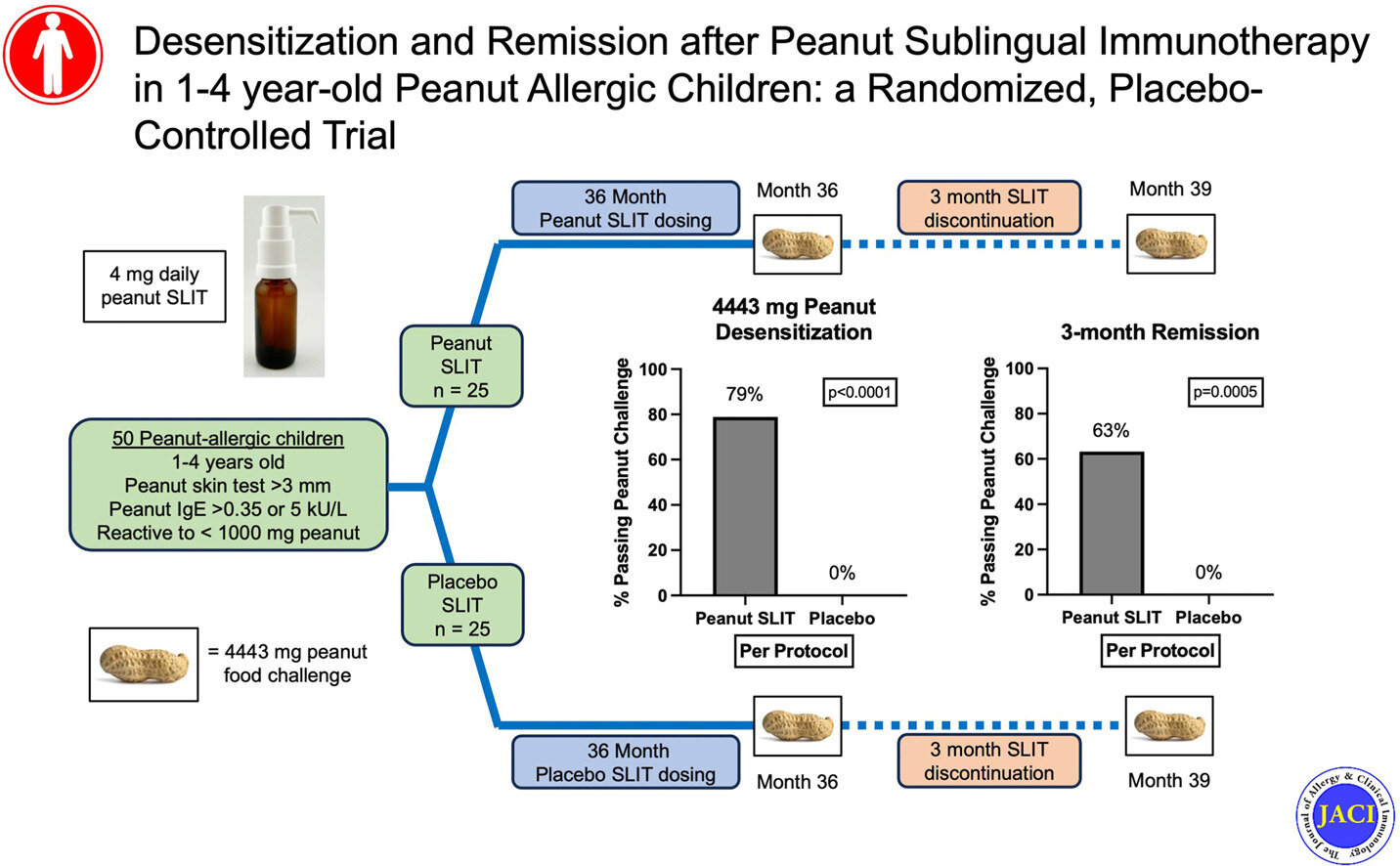
Is immunotherapy effective for all types of allergies? While immunotherapy can be highly effective for environmental allergies like pollen or dust mites, its use for food allergies is still being researched and is not yet widely available.
Emergency Treatment for Severe Allergic Reactions
Anaphylaxis is a severe, potentially life-threatening allergic reaction that requires immediate medical attention. Symptoms of anaphylaxis may include:
- Difficulty breathing or wheezing
- Swelling of the throat or tongue
- Dizziness or fainting
- Rapid, weak pulse
- Nausea and vomiting
The primary emergency treatment for anaphylaxis is epinephrine, typically administered via an auto-injector (e.g., EpiPen). Individuals with known severe allergies should always carry an epinephrine auto-injector and know how to use it.
Can anaphylaxis occur without previous allergic reactions? Yes, it’s possible for someone to experience anaphylaxis without any prior history of allergies. This underscores the importance of recognizing the signs and seeking immediate medical care.

Natural Remedies and Lifestyle Changes for Allergy Management
While medications play a crucial role in managing allergies, several natural remedies and lifestyle changes can complement traditional treatments:
Saline Nasal Rinses: Flushing Out Allergens
Saline nasal rinses, using devices like neti pots, can help flush out allergens and reduce nasal congestion. This method is particularly effective for individuals with seasonal allergies or chronic sinus issues.
Dietary Changes: The Gut-Allergy Connection
Emerging research suggests a link between gut health and allergies. Incorporating probiotic-rich foods or supplements may help modulate the immune system and reduce allergy symptoms in some individuals.
Environmental Controls: Minimizing Allergen Exposure
Implementing strategies to reduce allergen exposure in the home can significantly alleviate symptoms. These may include:
- Using high-efficiency particulate air (HEPA) filters
- Keeping windows closed during high pollen days
- Regularly washing bedding in hot water
- Vacuuming frequently with a HEPA-filter vacuum
Can dietary changes alone cure allergies? While dietary modifications may help some individuals manage their symptoms, they are unlikely to completely cure allergies. A comprehensive approach, often including medications and environmental controls, is typically necessary for effective allergy management.
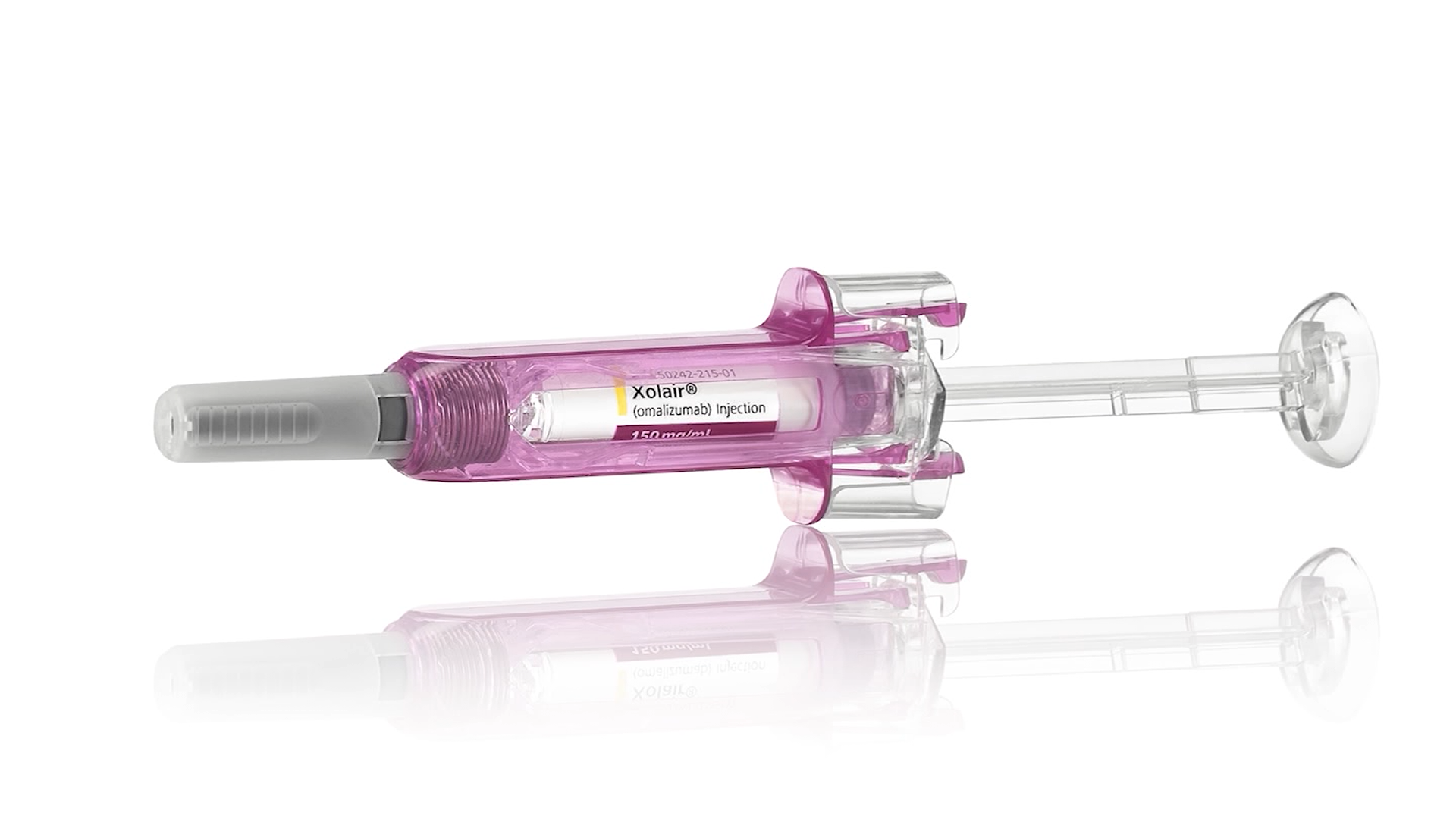
Potential Side Effects and Interactions of Allergy Medications
While allergy medications can provide significant relief, it’s important to be aware of potential side effects and interactions. Common side effects of antihistamines may include drowsiness, dry mouth, and blurred vision. Decongestants can cause insomnia, increased blood pressure, and nervousness.
Corticosteroids, especially when used long-term or in high doses, may lead to more serious side effects such as:
- Increased risk of infections
- Osteoporosis
- Cataracts
- Weight gain
- Mood changes
Are there any significant drug interactions to be aware of with allergy medications? Yes, several allergy medications can interact with other drugs. For example, some antihistamines may enhance the sedative effects of alcohol and certain antidepressants. Always consult with a healthcare provider or pharmacist about potential interactions, especially if you’re taking multiple medications.
The Future of Allergy Treatment: Emerging Therapies and Research
The field of allergy treatment is continuously evolving, with researchers exploring new approaches to manage and potentially cure allergies. Some promising areas of research include:

Biologics: Targeted Therapy for Severe Allergies
Biologic drugs, such as omalizumab (Xolair) and dupilumab (Dupixent), target specific components of the allergic response. These medications are currently used for severe asthma and eczema but are being studied for other allergic conditions.
Oral Immunotherapy for Food Allergies
Researchers are developing oral immunotherapy protocols to help individuals with food allergies build tolerance. While not yet widely available, this approach shows promise in reducing the risk of severe reactions to accidental exposures.
Gene Therapy: Addressing the Root Cause
Advances in gene therapy may one day allow for the correction of genetic predispositions to allergies, potentially offering a cure rather than just symptom management.
How close are we to finding a cure for allergies? While significant progress has been made in allergy treatment and management, a universal cure remains elusive. The complex nature of the immune system and the variety of allergens make developing a one-size-fits-all solution challenging. However, ongoing research continues to improve our understanding and treatment options for allergic conditions.

In conclusion, effective management of allergic reactions often requires a multifaceted approach, combining appropriate medications, lifestyle modifications, and in some cases, immunotherapy. As our understanding of allergies continues to grow, new and more targeted treatments are likely to emerge, offering hope for improved quality of life for millions of allergy sufferers worldwide. Always consult with a healthcare provider to determine the most appropriate treatment plan for your specific allergic condition.
How to treat an allergic reaction: Treatment and home remedies
We include products we think are useful for our readers. If you buy through links on this page, we may earn a small commission Here’s our process.
Medical News Today only shows you brands and products that we stand behind.
Our team thoroughly researches and evaluates the recommendations we make on our site. To establish that the product manufacturers addressed safety and efficacy standards, we:
- Evaluate ingredients and composition: Do they have the potential to cause harm?
- Fact-check all health claims: Do they align with the current body of scientific evidence?
- Assess the brand: Does it operate with integrity and adhere to industry best practices?
We do the research so you can find trusted products for your health and wellness.
Read more about our vetting process.
Was this helpful?
Allergies are a common cause of illness and can occur at any stage in someone’s life. Numerous different things cause allergies from pollen to food to medication, meaning it is not always easy to know the best treatments or home remedies.
Numerous different things cause allergies from pollen to food to medication, meaning it is not always easy to know the best treatments or home remedies.
According to the Centers for Disease Control (CDC), more than 50 million Americans experience an allergic reaction each year, and the best treatment will depend on the cause and severity of the reaction.
In this article, we take a close look at a range of treatments for allergic reactions, depending on a person’s symptoms and their severity, including anaphylaxis.
Fast facts on treating an allergic reaction:
- Most minor allergy symptoms can be treated with antihistamines, corticosteroids, or decongestants.
- Saline nasal rinses can be used for congestion-related allergy symptoms.
- Corticosteroid creams can treat skin rashes related to allergies.
- Immunotherapy is a long-term treatment option for chronic allergy symptoms.
- Anaphylaxis is a medical emergency, and people should call 911 if they suspect someone is having an anaphylactic reaction.

Was this helpful?
Share on PinterestMany people have allergies, which may cause symptoms such as coughing and sneezing.
An allergic reaction occurs when cells in the immune system interpret a foreign substance or allergen as harmful.
The immune system overreacts to these allergens and produces histamine, which is a chemical that causes allergy symptoms, such as inflammation, sneezing, and coughing.
Mild allergic reactions can usually be treated with home remedies and over-the-counter (OTC) medications.
However, chronic allergies need treatment from a medical professional. Severe allergic reactions always require emergency medical care.
Many mild to moderate allergic reactions can be treated at home or with OTC medications. The following treatments are commonly used to reduce the symptoms of an allergic reaction:
Antihistamines
Antihistamines can help to treat most minor allergic reactions regardless of the cause. These drugs reduce the body’s production of histamine, which reduces all symptoms, including sneezing, watering eyes, and skin reactions.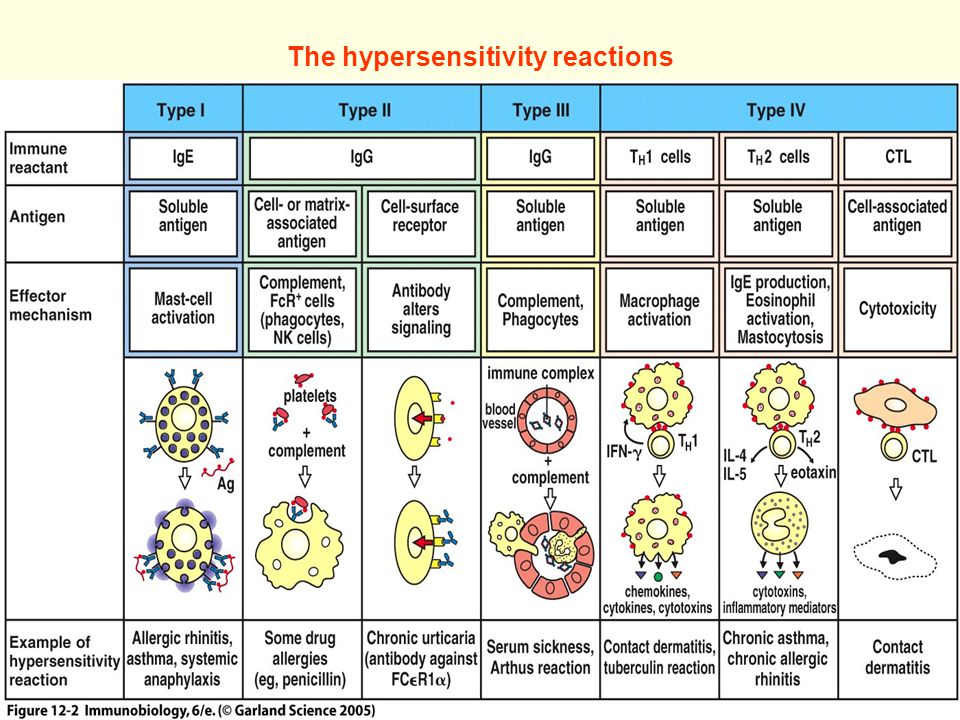
Second-generation antihistamines, including Claritin (loratadine) and Zyrtec (cetirizine), are less likely to cause drowsiness than first-generation antihistamines, such as Benadryl.
Antihistamines come in several forms, usually to help deliver the medication closer to the source of the reaction or make it easier to consume, such as:
- oral pills
- dissolvable tablets
- nasal sprays
- liquids
- eye drops
Antihistamines in these forms are available from pharmacies, to buy online, or on prescription from a doctor.
Antihistamines can also be taken to prevent allergies. Many people with seasonal or pet allergies will begin taking antihistamines when they know they are going to be exposed to an allergen.
A person who is pregnant or has a liver disorder should consult their doctor before taking antihistamines.
Nasal decongestants
Nasal decongestant pills, liquids, and sprays can also help reduce stuffy, swollen sinuses and related symptoms, such as a sore throat or coughing.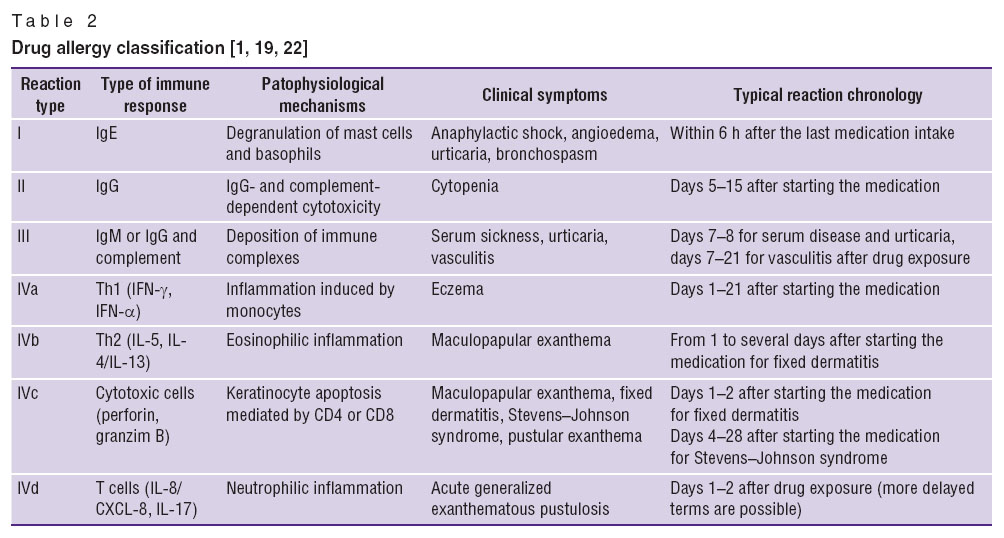
However, decongestant medications should not be taken continuously for more than 72 hours.
Nasal decongestants are available over the counter and online.
Anti-inflammatory medication
Non-steroidal anti-inflammatory medications (NSAIDs) may also be used to help temporarily reduce pain, swelling, and cramping caused by allergies.
Avoid the allergen
The best way to treat and prevent allergic reactions is to know what triggers the reaction and stay away from it, especially food allergens.
When this is not possible or realistic, using antihistamines or decongestants when in contact with allergens can help to treat the symptoms.
Use a saline sinus rinse
Share on PinterestA saline sinus rinse may treat symptoms such as a runny or itchy nose.
When allergies cause sinus problems, the American Academy of Allergy, Asthma & Immunology (AAAAI) recommend a person rinse their sinuses with saline. This can remove allergens and clear the airways.
The AAAAI recommend the following saline recipe:
- mix 3 teaspoons of salt (without iodide) with 1 teaspoon of baking soda
- add 1 teaspoon of this mixture to 8 ounces of boiled water
- dissolve the mixture in the water then use as a saline rinse
Sinus rinsing devices can be purchased online or from a pharmacy.
Treating environmental allergies
For airborne allergens, such as pollen, dust, and mold spores, additional treatment options include:
- throat lozenges with soothing ingredients, such as menthol, honey, or ginger
- shower and wash all clothing after being exposed to an allergen
- exercise for a few minutes to help reduce nasal congestion
Treating allergies on the skin
For allergic reactions that cause skin symptoms, including those associated with allergens found in animal saliva, poisonous plants, drugs, chemicals and metals, additional treatment options include:
- Topical corticosteroid creams or tablets.
 Corticosteroids contain steroids that reduce inflammation and itching. Mild forms of these creams can be found online, and a doctor can prescribe stronger versions.
Corticosteroids contain steroids that reduce inflammation and itching. Mild forms of these creams can be found online, and a doctor can prescribe stronger versions. - Moisturizing creams. Emollient creams with soothing ingredients, such as calamine can treat skin reactions.
- Bite or sting medication. Medication targeted to reduce allergic reactions to insect bites or stings have a similar effect to other allergy medications.
- Ice pack. Applying an ice pack wrapped in cloth to the area for 10- to 15-minute intervals can reduce inflammation.
Treating severe allergies
People should speak to a professional if they have or suspect that they have severe or chronic allergies.
A doctor or allergy specialist can prescribe medications that contain much stronger doses of the compounds found in OTC products.
Treatment options for chronic or severe allergies include:
- Immunotherapy, or allergy shots.
 Immunotherapy can be between 90 and 98 percent effective at reducing allergic reactions to insect stings, for instance.
Immunotherapy can be between 90 and 98 percent effective at reducing allergic reactions to insect stings, for instance. - Prescription asthma medications, such as bronchodilators and inhaled corticosteroids.
- Oral cromolyn can be taken for food allergies.
- Drug desensitization therapy is used for specific allergens.
Many traditional medicine systems use herbal supplements and extracts to both treat and prevent allergic reactions, especially seasonal allergies.
Though there is little scientific evidence to support the use of most alternative or natural remedies, some people may find that some can provide relief from their symptoms.
The American Association of Naturopathic Physicians recommend the following natural treatments for allergies:
- Dietary changes. A low-fat diet high in complex carbohydrates, such as beans, whole grains, and vegetables may reduce allergy reactions.
- Bioflavonoids. These plant-based chemicals found in citrus fruits and blackcurrants may act as natural antihistamines.
 These can also be taken as supplements.
These can also be taken as supplements. - Supplements. Flaxseed oil, zinc, and vitamins A, C, and E are suggested to improve allergy symptoms.
- Acupuncture. Acupuncture treatments may help some people to find relief from their symptoms.
Share on PinterestAn EpiPen is designed to treat anaphylaxis, and should be used at the first sign of a severe allergc reaction.
A very severe allergic reaction can lead to a condition called anaphylaxis, or anaphylactic shock.
Anaphylaxis occurs when the body’s immune response to an allergen is so severe and sudden that the body goes into a state of shock.
Anaphylaxis can impact multiple organs and if left untreated lead to coma, organ failure, and death.
The early symptoms of anaphylaxis can be fairly mild and similar to those of minor to moderate allergic reactions, but they often rapidly worsen.
Symptoms unique to anaphylaxis include:
- unexplained anxiety
- tingling in the palms of the hand, soles of the feet, and lips
- swollen tongue, throat, mouth, and face
- difficulty breathing
- rapid but weak pulse
- low blood pressure
- sense of dread or doom
- vomiting or diarrhea
- confusion or disorientation
- loss of consciousness
- very pale or blue skin
- a heart attack
Anyone who suspects anaphylaxis should call 911 and seek emergency medical care.
If the person carries an EpiPen, which is a self-injectable dose of epinephrine that is designed to treat anaphylaxis, inject this into their thigh, as soon as possible.
First aid for anaphylaxis includes:
- try to keep the person calm
- the person may vomit, so turn them on their side and keep their mouth clear
- try to get the person to lay flat on their back with their feet raised about a foot above the ground
- make sure the person’s clothing is loose or remove constricting clothing
- do not give them anything to drink or eat, even if they ask for it
- if they are not breathing, practice CPR with around 100 firm chest compressions every minute until emergency services arrive
If a person does not have an EpiPen, a doctor or paramedic will give an injection of the hormone epinephrine, or adrenaline. This will immediately increase the output of the heart and blood flow throughout the body.
A person should seek medical care each time anaphylaxis occurs. Even if they start to feel better or their symptoms go away, a second severe allergic reaction can occur up to 12 hours after the initial response.
Even if they start to feel better or their symptoms go away, a second severe allergic reaction can occur up to 12 hours after the initial response.
The symptoms associated with an allergic response depend on the specific allergen, how severe the allergy is, and whether a person has touched, swallowed, or inhaled the allergen.
Not everyone responds the same way to each allergen. But there are similar sets of symptoms most people experience when exposed to specific allergens.
Common symptoms associated with different type of allergens include:
| Airborne allergens | Animal saliva | Insect stings/bites | Food allergens | Drug allergens | Metal/ chemical allergens | |
| Sneezing/ itchy nose | Y | Y | ||||
| Runny/stuffy nose | Y | Y | ||||
| Coughing | Y | Y | ||||
| Skin rash/itchy skin | Y | Y | Y | Y | Y | |
| Wheezing/ shortness of breath | Y | Y | ||||
| Hives/welts | Y | Y | Y | Y | ||
| Pain, redness and swelling at the exposure point | Y | Y | Y | Y | ||
| Peeling /blistering skin | Y | Y | ||||
| Watery, itchy, red eyes | Y | Y | ||||
| Sore throat | ||||||
| Vomiting, nausea, or diarrhea | Y | |||||
| Swelling of the throat, tongue, and mouth | Y | Y | Y | |||
| Dizziness | Y | Y | Y | |||
| Sun sensitivity | Y | |||||
| Itchy mouth/odd taste in the mouth | Y | Y | ||||
| Pale skin | Y | Y | ||||
| Swelling of the eyes, face, and genitals | Y | |||||
| Chronic joint or muscle pain | Y | Y |
Many people experience allergic reactions when they are exposed to specific allergens, ranging from pet dander and pollen to compounds in foods, drinks, and personal hygiene products.
The best way to treat an allergic reaction depends on the cause, though most minor cases can be treated with OTC antihistamine and anti-itch products.
A person should seek immediate medical attention for chronic or severe allergic reactions, especially those that involve swelling of the throat or changes in heart rate. Anaphylaxis should always be treated as a medical emergency.
How to treat an allergic reaction: Treatment and home remedies
We include products we think are useful for our readers. If you buy through links on this page, we may earn a small commission Here’s our process.
Medical News Today only shows you brands and products that we stand behind.
Our team thoroughly researches and evaluates the recommendations we make on our site. To establish that the product manufacturers addressed safety and efficacy standards, we:
- Evaluate ingredients and composition: Do they have the potential to cause harm?
- Fact-check all health claims: Do they align with the current body of scientific evidence?
- Assess the brand: Does it operate with integrity and adhere to industry best practices?
We do the research so you can find trusted products for your health and wellness.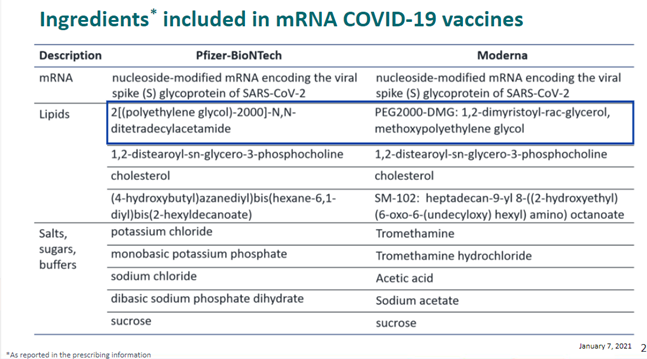
Read more about our vetting process.
Was this helpful?
Allergies are a common cause of illness and can occur at any stage in someone’s life. Numerous different things cause allergies from pollen to food to medication, meaning it is not always easy to know the best treatments or home remedies.
According to the Centers for Disease Control (CDC), more than 50 million Americans experience an allergic reaction each year, and the best treatment will depend on the cause and severity of the reaction.
In this article, we take a close look at a range of treatments for allergic reactions, depending on a person’s symptoms and their severity, including anaphylaxis.
Fast facts on treating an allergic reaction:
- Most minor allergy symptoms can be treated with antihistamines, corticosteroids, or decongestants.
- Saline nasal rinses can be used for congestion-related allergy symptoms.
- Corticosteroid creams can treat skin rashes related to allergies.

- Immunotherapy is a long-term treatment option for chronic allergy symptoms.
- Anaphylaxis is a medical emergency, and people should call 911 if they suspect someone is having an anaphylactic reaction.
Was this helpful?
Share on PinterestMany people have allergies, which may cause symptoms such as coughing and sneezing.
An allergic reaction occurs when cells in the immune system interpret a foreign substance or allergen as harmful.
The immune system overreacts to these allergens and produces histamine, which is a chemical that causes allergy symptoms, such as inflammation, sneezing, and coughing.
Mild allergic reactions can usually be treated with home remedies and over-the-counter (OTC) medications.
However, chronic allergies need treatment from a medical professional. Severe allergic reactions always require emergency medical care.
Many mild to moderate allergic reactions can be treated at home or with OTC medications. The following treatments are commonly used to reduce the symptoms of an allergic reaction:
Antihistamines
Antihistamines can help to treat most minor allergic reactions regardless of the cause. These drugs reduce the body’s production of histamine, which reduces all symptoms, including sneezing, watering eyes, and skin reactions.
These drugs reduce the body’s production of histamine, which reduces all symptoms, including sneezing, watering eyes, and skin reactions.
Second-generation antihistamines, including Claritin (loratadine) and Zyrtec (cetirizine), are less likely to cause drowsiness than first-generation antihistamines, such as Benadryl.
Antihistamines come in several forms, usually to help deliver the medication closer to the source of the reaction or make it easier to consume, such as:
- oral pills
- dissolvable tablets
- nasal sprays
- liquids
- eye drops
Antihistamines in these forms are available from pharmacies, to buy online, or on prescription from a doctor.
Antihistamines can also be taken to prevent allergies. Many people with seasonal or pet allergies will begin taking antihistamines when they know they are going to be exposed to an allergen.
A person who is pregnant or has a liver disorder should consult their doctor before taking antihistamines.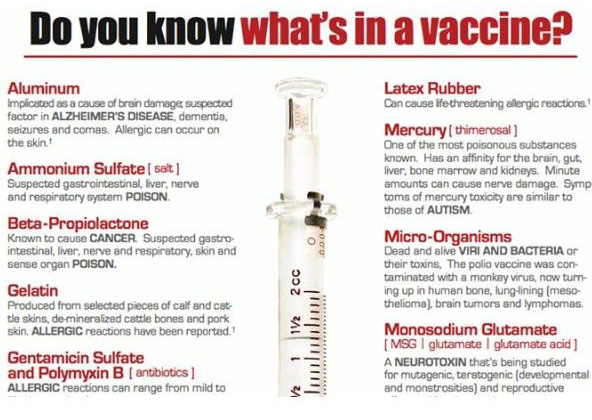
Nasal decongestants
Nasal decongestant pills, liquids, and sprays can also help reduce stuffy, swollen sinuses and related symptoms, such as a sore throat or coughing.
However, decongestant medications should not be taken continuously for more than 72 hours.
Nasal decongestants are available over the counter and online.
Anti-inflammatory medication
Non-steroidal anti-inflammatory medications (NSAIDs) may also be used to help temporarily reduce pain, swelling, and cramping caused by allergies.
Avoid the allergen
The best way to treat and prevent allergic reactions is to know what triggers the reaction and stay away from it, especially food allergens.
When this is not possible or realistic, using antihistamines or decongestants when in contact with allergens can help to treat the symptoms.
Use a saline sinus rinse
Share on PinterestA saline sinus rinse may treat symptoms such as a runny or itchy nose.
When allergies cause sinus problems, the American Academy of Allergy, Asthma & Immunology (AAAAI) recommend a person rinse their sinuses with saline.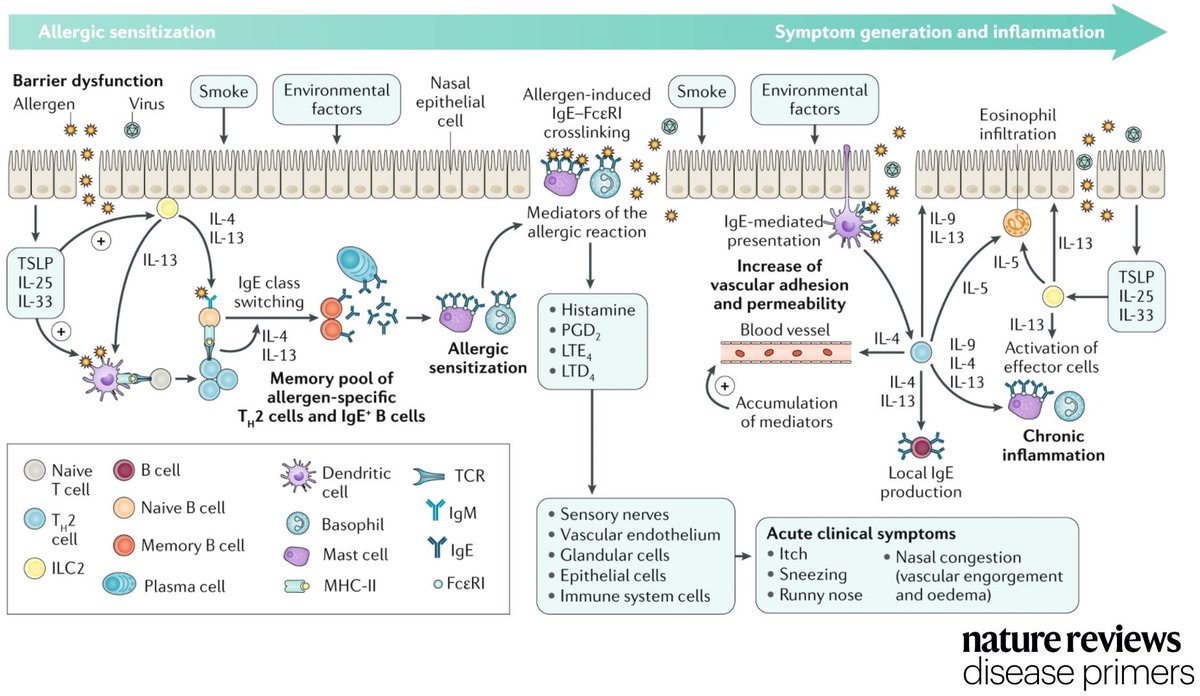 This can remove allergens and clear the airways.
This can remove allergens and clear the airways.
The AAAAI recommend the following saline recipe:
- mix 3 teaspoons of salt (without iodide) with 1 teaspoon of baking soda
- add 1 teaspoon of this mixture to 8 ounces of boiled water
- dissolve the mixture in the water then use as a saline rinse
Sinus rinsing devices can be purchased online or from a pharmacy.
Treating environmental allergies
For airborne allergens, such as pollen, dust, and mold spores, additional treatment options include:
- throat lozenges with soothing ingredients, such as menthol, honey, or ginger
- shower and wash all clothing after being exposed to an allergen
- exercise for a few minutes to help reduce nasal congestion
Treating allergies on the skin
For allergic reactions that cause skin symptoms, including those associated with allergens found in animal saliva, poisonous plants, drugs, chemicals and metals, additional treatment options include:
- Topical corticosteroid creams or tablets.
 Corticosteroids contain steroids that reduce inflammation and itching. Mild forms of these creams can be found online, and a doctor can prescribe stronger versions.
Corticosteroids contain steroids that reduce inflammation and itching. Mild forms of these creams can be found online, and a doctor can prescribe stronger versions. - Moisturizing creams. Emollient creams with soothing ingredients, such as calamine can treat skin reactions.
- Bite or sting medication. Medication targeted to reduce allergic reactions to insect bites or stings have a similar effect to other allergy medications.
- Ice pack. Applying an ice pack wrapped in cloth to the area for 10- to 15-minute intervals can reduce inflammation.
Treating severe allergies
People should speak to a professional if they have or suspect that they have severe or chronic allergies.
A doctor or allergy specialist can prescribe medications that contain much stronger doses of the compounds found in OTC products.
Treatment options for chronic or severe allergies include:
- Immunotherapy, or allergy shots.
 Immunotherapy can be between 90 and 98 percent effective at reducing allergic reactions to insect stings, for instance.
Immunotherapy can be between 90 and 98 percent effective at reducing allergic reactions to insect stings, for instance. - Prescription asthma medications, such as bronchodilators and inhaled corticosteroids.
- Oral cromolyn can be taken for food allergies.
- Drug desensitization therapy is used for specific allergens.
Many traditional medicine systems use herbal supplements and extracts to both treat and prevent allergic reactions, especially seasonal allergies.
Though there is little scientific evidence to support the use of most alternative or natural remedies, some people may find that some can provide relief from their symptoms.
The American Association of Naturopathic Physicians recommend the following natural treatments for allergies:
- Dietary changes. A low-fat diet high in complex carbohydrates, such as beans, whole grains, and vegetables may reduce allergy reactions.
- Bioflavonoids. These plant-based chemicals found in citrus fruits and blackcurrants may act as natural antihistamines.
 These can also be taken as supplements.
These can also be taken as supplements. - Supplements. Flaxseed oil, zinc, and vitamins A, C, and E are suggested to improve allergy symptoms.
- Acupuncture. Acupuncture treatments may help some people to find relief from their symptoms.
Share on PinterestAn EpiPen is designed to treat anaphylaxis, and should be used at the first sign of a severe allergc reaction.
A very severe allergic reaction can lead to a condition called anaphylaxis, or anaphylactic shock.
Anaphylaxis occurs when the body’s immune response to an allergen is so severe and sudden that the body goes into a state of shock.
Anaphylaxis can impact multiple organs and if left untreated lead to coma, organ failure, and death.
The early symptoms of anaphylaxis can be fairly mild and similar to those of minor to moderate allergic reactions, but they often rapidly worsen.
Symptoms unique to anaphylaxis include:
- unexplained anxiety
- tingling in the palms of the hand, soles of the feet, and lips
- swollen tongue, throat, mouth, and face
- difficulty breathing
- rapid but weak pulse
- low blood pressure
- sense of dread or doom
- vomiting or diarrhea
- confusion or disorientation
- loss of consciousness
- very pale or blue skin
- a heart attack
Anyone who suspects anaphylaxis should call 911 and seek emergency medical care.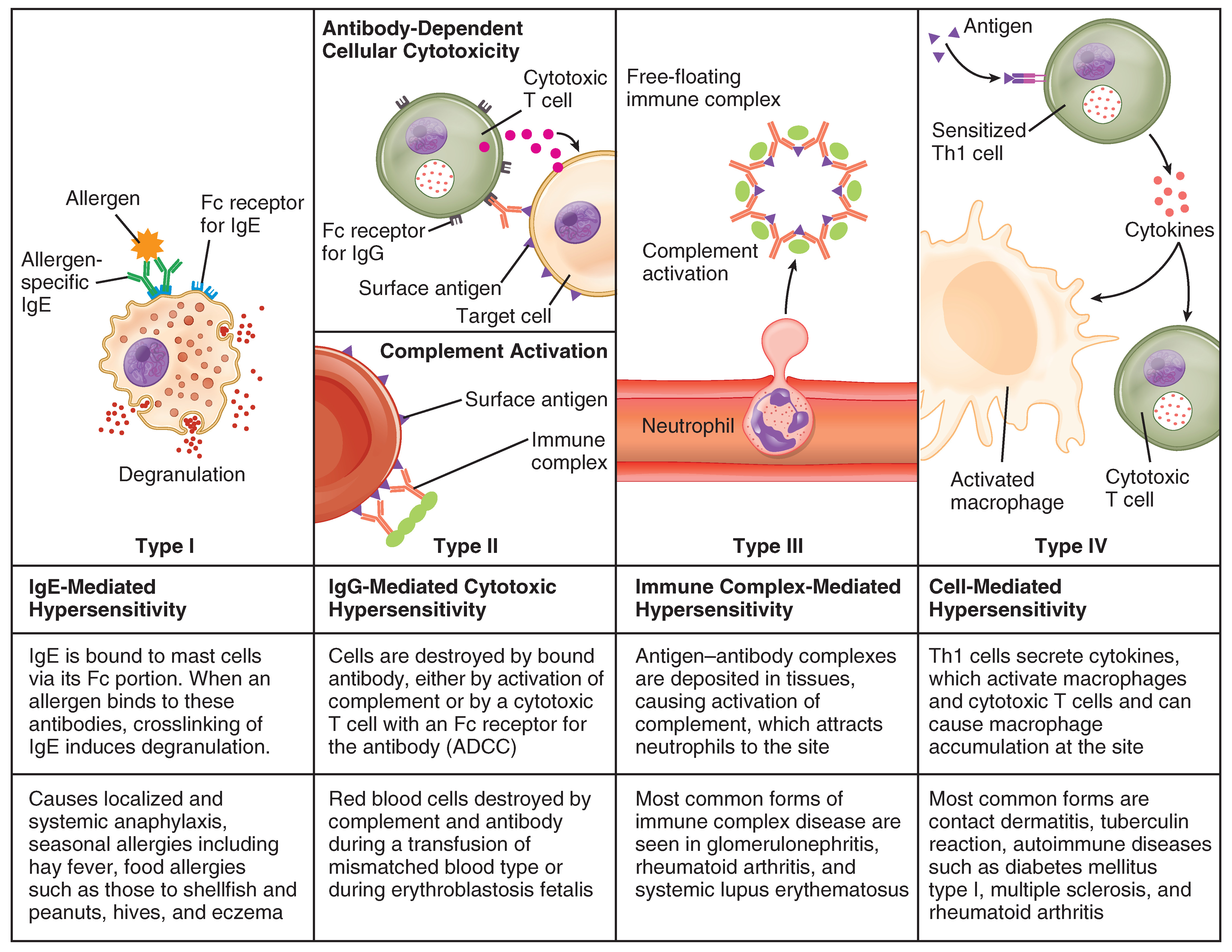
If the person carries an EpiPen, which is a self-injectable dose of epinephrine that is designed to treat anaphylaxis, inject this into their thigh, as soon as possible.
First aid for anaphylaxis includes:
- try to keep the person calm
- the person may vomit, so turn them on their side and keep their mouth clear
- try to get the person to lay flat on their back with their feet raised about a foot above the ground
- make sure the person’s clothing is loose or remove constricting clothing
- do not give them anything to drink or eat, even if they ask for it
- if they are not breathing, practice CPR with around 100 firm chest compressions every minute until emergency services arrive
If a person does not have an EpiPen, a doctor or paramedic will give an injection of the hormone epinephrine, or adrenaline. This will immediately increase the output of the heart and blood flow throughout the body.
A person should seek medical care each time anaphylaxis occurs. Even if they start to feel better or their symptoms go away, a second severe allergic reaction can occur up to 12 hours after the initial response.
Even if they start to feel better or their symptoms go away, a second severe allergic reaction can occur up to 12 hours after the initial response.
The symptoms associated with an allergic response depend on the specific allergen, how severe the allergy is, and whether a person has touched, swallowed, or inhaled the allergen.
Not everyone responds the same way to each allergen. But there are similar sets of symptoms most people experience when exposed to specific allergens.
Common symptoms associated with different type of allergens include:
| Airborne allergens | Animal saliva | Insect stings/bites | Food allergens | Drug allergens | Metal/ chemical allergens | |
| Sneezing/ itchy nose | Y | Y | ||||
| Runny/stuffy nose | Y | Y | ||||
| Coughing | Y | Y | ||||
| Skin rash/itchy skin | Y | Y | Y | Y | Y | |
| Wheezing/ shortness of breath | Y | Y | ||||
| Hives/welts | Y | Y | Y | Y | ||
| Pain, redness and swelling at the exposure point | Y | Y | Y | Y | ||
| Peeling /blistering skin | Y | Y | ||||
| Watery, itchy, red eyes | Y | Y | ||||
| Sore throat | ||||||
| Vomiting, nausea, or diarrhea | Y | |||||
| Swelling of the throat, tongue, and mouth | Y | Y | Y | |||
| Dizziness | Y | Y | Y | |||
| Sun sensitivity | Y | |||||
| Itchy mouth/odd taste in the mouth | Y | Y | ||||
| Pale skin | Y | Y | ||||
| Swelling of the eyes, face, and genitals | Y | |||||
| Chronic joint or muscle pain | Y | Y |
Many people experience allergic reactions when they are exposed to specific allergens, ranging from pet dander and pollen to compounds in foods, drinks, and personal hygiene products.
The best way to treat an allergic reaction depends on the cause, though most minor cases can be treated with OTC antihistamine and anti-itch products.
A person should seek immediate medical attention for chronic or severe allergic reactions, especially those that involve swelling of the throat or changes in heart rate. Anaphylaxis should always be treated as a medical emergency.
Read online “100 Food Recipes for Food Allergies. Tasty, healthy, sincere, healing”, Irina Vecherskaya – Litres
© Centerpolygraph, 2016
Foreword
Food allergy is characterized by increased sensitivity of the body to food products and the development of signs of food intolerance caused by the reaction of the immune system.
Normal digestion and absorption of food products is ensured by the state of the endocrine system, the structure and function of the gastrointestinal tract, the biliary system, the composition and volume of digestive juices, the composition of the intestinal microflora, the state of local immunity of the intestinal mucosa.:max_bytes(150000):strip_icc()/hormone-allergy-82663-ca91df10002742eeab0c0618d95fbaaf.jpg)
Normally, foods are broken down into compounds that do not have allergenic properties, and the intestinal wall is impermeable to undigested foods.
The development of food allergy is provoked by the following factors:
– first of all, this is an increase in the permeability of the intestinal wall, which is observed in inflammatory diseases of the gastrointestinal tract;
– violation (decrease or acceleration) of the absorption of food compounds may be due to a violation of the stages of digestion in case of insufficient pancreatic function, enzyme deficiency, biliary tract and intestinal dyskinesia, etc.;
– erratic eating, rare or frequent meals lead to impaired gastric secretion, the development of gastritis and other disorders that cause the formation of food allergies or pseudo-allergies;
– the formation of hypersensitivity to foods of a protein nature is influenced not only by the amount of food taken and diet violations, but also by the acidity of gastric juice.
Skin manifestations:
– urticaria or simple redness,
– eczema,
– itching and dryness,
– various rashes.
Gastrointestinal manifestations:
– abdominal pain,
– dyspepsia – vomiting, nausea or diarrhea,
– itching in the mouth or swelling of the mucous membranes.
Respiratory system:
– redness,
– itching,
– swelling and nasal congestion,
– allergic cough.
Eye manifestations:
– itching,
– redness of the conjunctiva,
– lacrimation.
Cardiovascular manifestations:
– chest pain,
– abnormal heart rhythm.
– hypertension,
– fainting, loss of consciousness.
The only treatment currently available is to avoid exposure to the allergen. No other attempts to cure this disorder have been successful. The main principles of prescribing a diet are the exclusion from the diet of such foods that have a rather high allergic activity, irritate the gastrointestinal mucosa and contain emulsifiers, dyes, preservatives, stabilizers.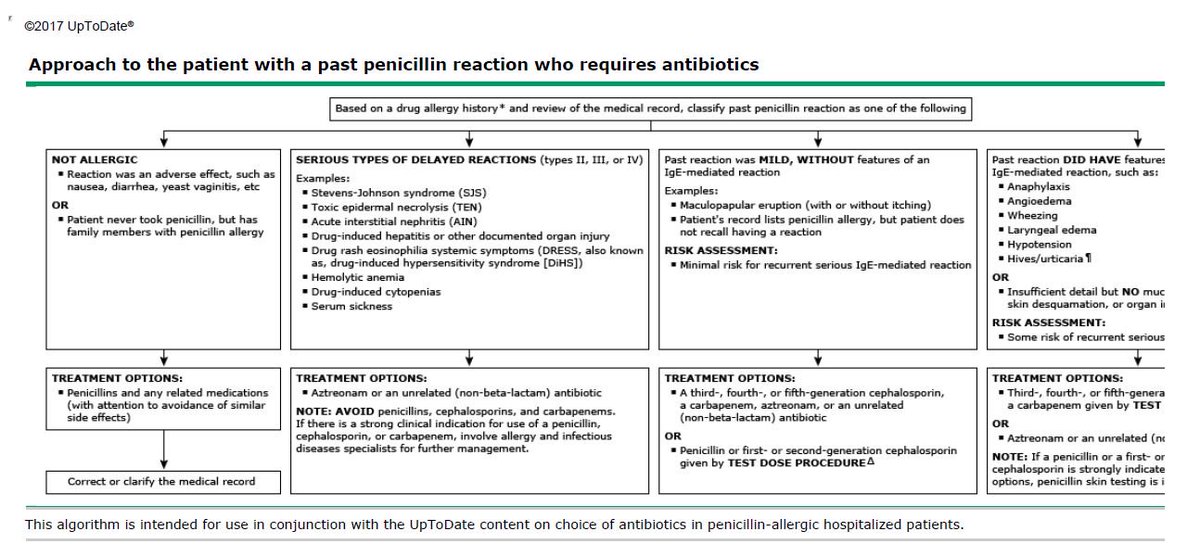 It is also necessary, when compiling a diet, to replace intolerable foods with natural and specialized ones.
It is also necessary, when compiling a diet, to replace intolerable foods with natural and specialized ones.
Allergy Diets
The Food Allergy Diet will slowly but surely get rid of your unpleasant symptoms, and you will be able to return your favorite foods to your diet – but carefully and little by little.
The food allergy diet can be conditionally divided into several stages.
Elimination. Such food for allergies involves the exclusion from the diet of those foods that are causally significant allergens.
Hypoallergenic. This is an exception to products that are not allergens themselves, but contribute to the appearance of allergic reactions. Includes such products as: honey, chocolate, citrus fruits, nuts, eggs, sauerkraut, orange and red fruits.
Elimination diet
1 option. Starts with either 1-2 days of fasting on water or 1-3 days of tea with a little sugar (5 glasses a day) and 250 g of toasted white bread. Then every 2-3 days the diet is slightly expanded. First, fermented milk products are introduced into the diet in the following sequence: kefir, cottage cheese, milk, cheese. Then add meat, even later – fish or vegetable dishes.
Then every 2-3 days the diet is slightly expanded. First, fermented milk products are introduced into the diet in the following sequence: kefir, cottage cheese, milk, cheese. Then add meat, even later – fish or vegetable dishes.
2nd option. Eating pears (or green apples), turkey (or lamb) and rice. Gradually, a variety of vegetables are introduced into the diet – preferably those that are eaten infrequently: parsnips, turnips, carrots.
If the allergy does not aggravate when using the newly introduced product, another previously excluded product is introduced after 4 days.
Dyes, additives prohibited for allergy sufferers: E100, E101, E102, E104, E107, E110, E120, E122-E124, E127-E129, E131-E133, E141.
Hypoallergenic diet
This is one of the ways to treat all types of allergies, as it helps to identify the true cause of the disease.
The main indication for the appointment of this diet is food allergy, since the main tasks of this diet are the direct elimination of factors, that is, the products themselves, that lead to an allergic reaction and reduce the allergenic load on the body.
Nutrition is physiologically complete and sparing, with restriction of salt intake to 7 g per day. All dishes are served only boiled, soups are cooked with a threefold change of broth, especially when cooking meat, fish, chicken.
The approximate energy value of this diet is 2800 kcal per day. You need to eat fractionally, at least 6 times a day.
In the presence of edema, it is recommended to limit free fluid intake.
A hypoallergenic diet completely excludes all food allergens, including:
– meat and fish products (including caviar),
– citrus fruits,
– all types of nuts,
– fruits and berries of red and orange,
– melon and pineapple,
– sharp vegetables (radish, horseradish, radishes),
– chocolate and coffee,
– honey, sugar, jam, pastry pastries and all types of confectionery,
– salted and smoked products
Mayonnaise and ketchup
Juices
Eggs
Mushrooms
Poultry meat (excluding white chicken and turkey meat) spicy cheese,
– all industrial products production (excluding baby food),
– alcoholic beverages,
– remove foods to which the patient has an individual intolerance.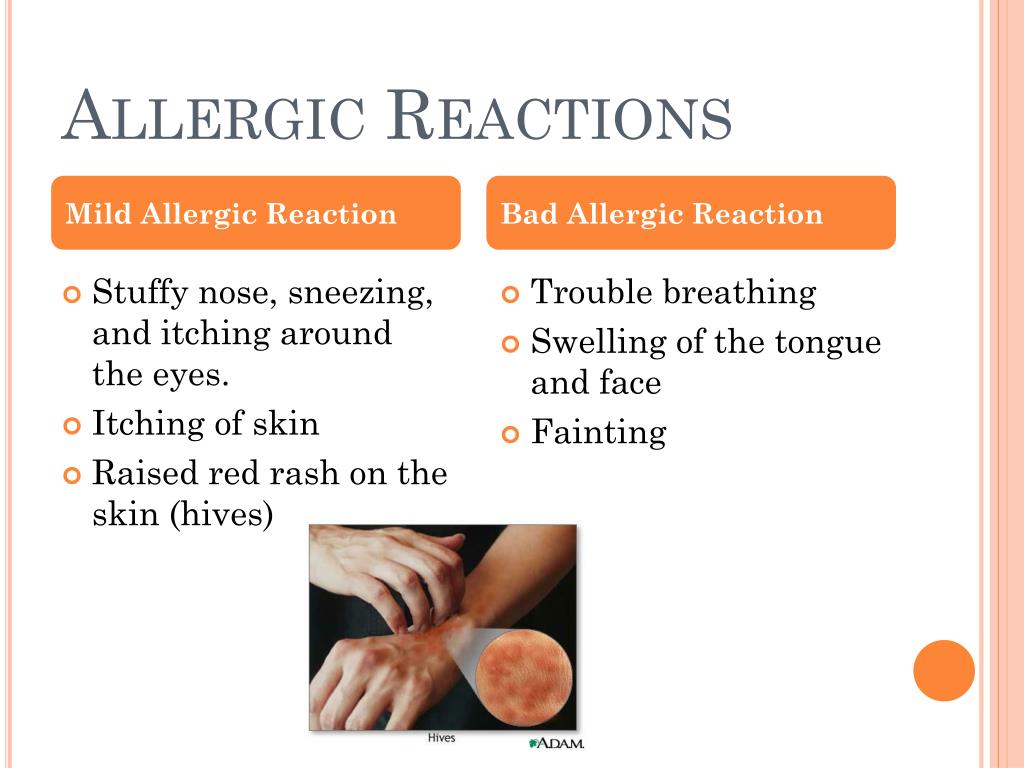
The following products are most often allowed to be included in the hypoallergenic diet menu:
– meat: boiled beef, white meat of chicken and turkey,
– vegetarian soups cooked from approved products,
– vegetable oil: olive, sunflower,
– cereals: rice, buckwheat, oatmeal,
– lactic acid products: cottage cheese, curdled milk, kefir and yogurt without additives are allowed,
– Cheese cheese,
– Vegetables: cucumbers, cabbage, leafy greens, potatoes, green peas
– Fruits: green apples, preferably baked, pears 02 – dried white bread, unleavened cakes, unleavened lavash.
Exit from the diet. The duration of the diet can be from two to three weeks for adults and up to 10 days for children. When allergy symptoms cease to appear, that is, after 2-3 weeks from the moment of improvement, you can gradually return foods to the diet, but strictly one at a time and in reverse order – from low-allergenic to highly allergenic.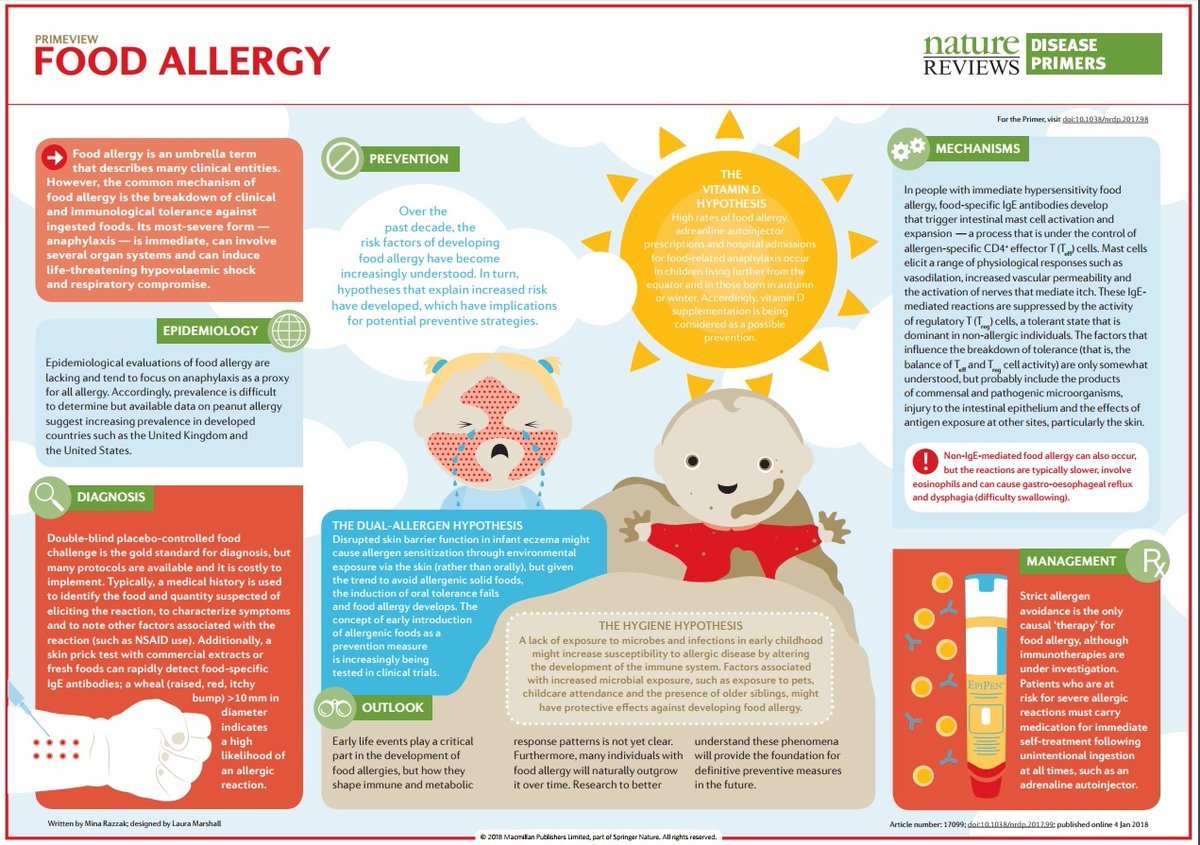 A new product is introduced once every three days. If deterioration has occurred, then the last product is an allergen and should not be eaten.
A new product is introduced once every three days. If deterioration has occurred, then the last product is an allergen and should not be eaten.
Principles of nutrition for allergies
The key to food allergies is getting the right foods. 93% of food allergies are caused by just 8 foods. In descending order of allergenic properties, they are as follows: eggs, peanuts, milk, soy, tree nuts, fish, crustaceans, wheat.
Apples and pears, peaches and plums, carrots and potatoes, green beans, marrows and squash are considered non-allergenic. Rarely cause allergies to turkey and lamb meat, rice, barley, oats and rye.
Food allergy associated with the general. People who are allergic to tree pollen, stop eating: stone fruits and fruits, nuts, celery, dill, carrots. People who are allergic to cereals and meadow herbs, limit the use of bread, bakery products. Prohibited products: bread kvass, pasta, semolina, breadcrumbs, ice cream, halva, beans, sorrel.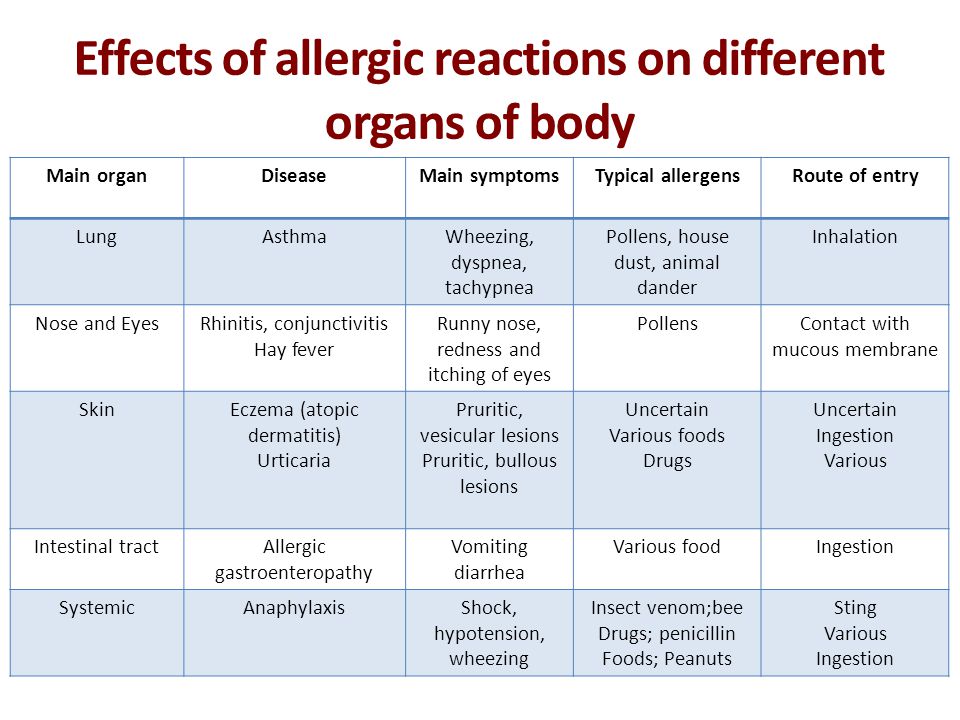 People who are allergic to composite plants (wormwood, etc.), stop eating: melon, watermelon, herbs, hot spices, sunflower oil, mayonnaise, mustard, halva, and also stop drinking: vermouth, absinthe, herbal preparations with the addition of coltsfoot, succession, yarrow. People who are allergic to quinoa stop eating: spinach, beets, peach, pear, mango, kiwi, pineapple, honey, mustard. People who are allergic to aspirin, salicylates, other medicines, should not eat: citrus fruits, berries, peaches, melon, plums, cucumbers, peppers, tomatoes, potatoes. Also, you can not use such medicinal herbs: willow bark, raspberry leaf, meadowsweet, marsh cinquefoil, peony, marin root.
People who are allergic to composite plants (wormwood, etc.), stop eating: melon, watermelon, herbs, hot spices, sunflower oil, mayonnaise, mustard, halva, and also stop drinking: vermouth, absinthe, herbal preparations with the addition of coltsfoot, succession, yarrow. People who are allergic to quinoa stop eating: spinach, beets, peach, pear, mango, kiwi, pineapple, honey, mustard. People who are allergic to aspirin, salicylates, other medicines, should not eat: citrus fruits, berries, peaches, melon, plums, cucumbers, peppers, tomatoes, potatoes. Also, you can not use such medicinal herbs: willow bark, raspberry leaf, meadowsweet, marsh cinquefoil, peony, marin root.
Some products are more likely to cause hypersensitivity than others.
Cow’s milk is a common allergen, which is especially important to consider when feeding young children. The slightest amount of this allergen is enough to develop a serious condition in a child whose immune system has not had time to fully form. There were cases when a child died not even from taking milk food, but only from milk dust, if the remains of milk were on the diapers on which the baby was placed.
There were cases when a child died not even from taking milk food, but only from milk dust, if the remains of milk were on the diapers on which the baby was placed.
Chicken egg is also one of the leading food allergens. It is interesting that sometimes hypersensitivity is manifested only on the protein, and sometimes only on the yolk (it happens that both components cause allergies). In the presence of an allergy to a chicken egg, an allergy is often observed to chicken meat (less often – ducks), other types of eggs (duck, goose), as well as to dishes containing eggs (mayonnaise, creams, rich and flour products, champagne and all white wines clarified with egg white). In addition, hypersensitivity to eggs may be accompanied by an allergic reaction of the respiratory tract to feather pillows.
Remember that vaccines (such as those against measles, mumps and rubella) also contain a small amount of egg proteins. And this is enough to cause serious reactions in people with allergies to the vaccine.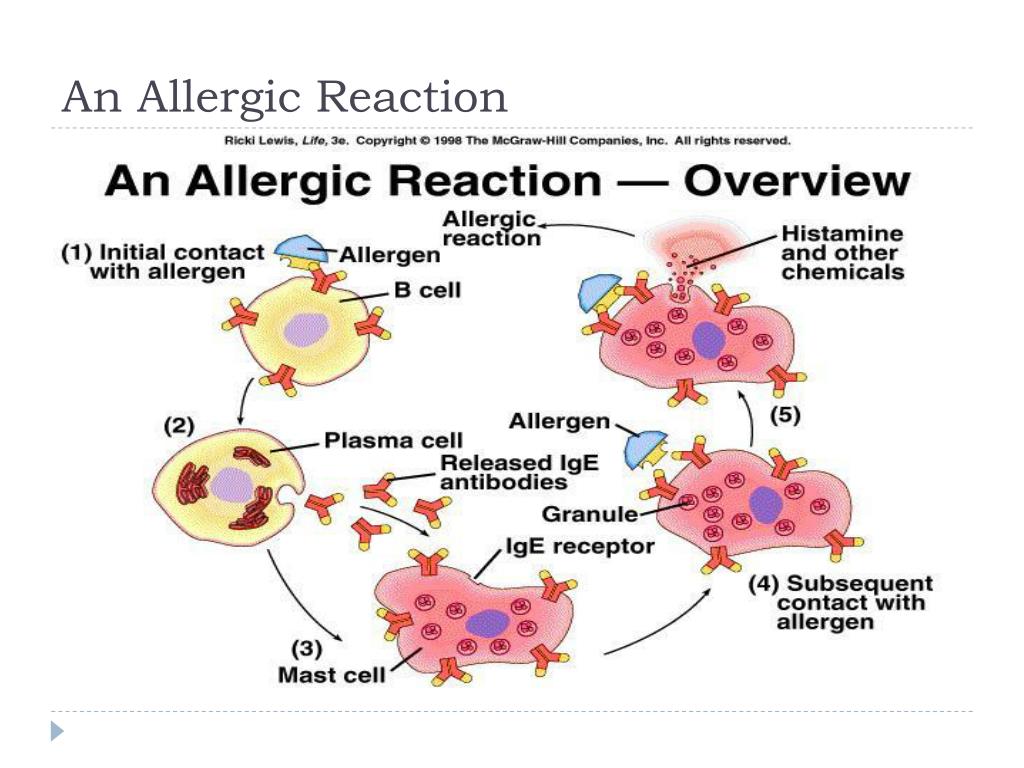
If you are not allergic to chicken eggs or chicken meat itself, then it is possible that it is not these products that cause your hypersensitivity, but the components of the feed that were given to the chicken (for example, if you are hypersensitive to tetracycline, an allergic reaction is quite likely on the meat of birds fed with this preparation).
Fish (sea and river), as well as various fish products (caviar, fish oil) are common allergens. Heat treatment practically does not reduce their allergenicity. During cooking, allergens enter the broth and even water vapor, the inhalation of which can also cause allergic reactions. People who are sensitive to fish are often allergic to the smell of fish food (daphnia). Keep in mind that even the use of cosmetic shadows that are prepared from fish scales can cause an allergic reaction.
Shellfish – crayfish, crabs, lobsters – quite allergenic.
Among fruits, berries and vegetables the most frequently allergic are strawberries, strawberries, citrus fruits (oranges, tangerines, lemons). Yellow, red, pink vegetables (tomatoes, carrots, peaches, etc.) are more likely to cause allergies than green ones.
Yellow, red, pink vegetables (tomatoes, carrots, peaches, etc.) are more likely to cause allergies than green ones.
Nuts are quite strong allergens. Keep in mind that some nuts are chemically similar (e.g. walnuts and almonds; cashews and pistachios). Therefore, an allergy to one type of nut is often accompanied by an allergy to another type.
The most common hypersensitivity to peanuts and numerous products containing them (cookies, chocolate, peanut butter, etc.). Also, with it, an allergic reaction to cosmetic preparations (creams, shower gels, shampoos, etc.) is possible, which contain this nut or its oil.
Honey, mushrooms, cocoa, chocolate, coffee have pronounced allergic properties. With hypersensitivity to coffee and cocoa, an allergy to other legumes (peas, beans, lentils, etc.) is also possible.
Alcoholic beverages, yeast dough, cheeses and cured meats. These products contain histamine, which is produced by certain bacteria and causes allergic reactions.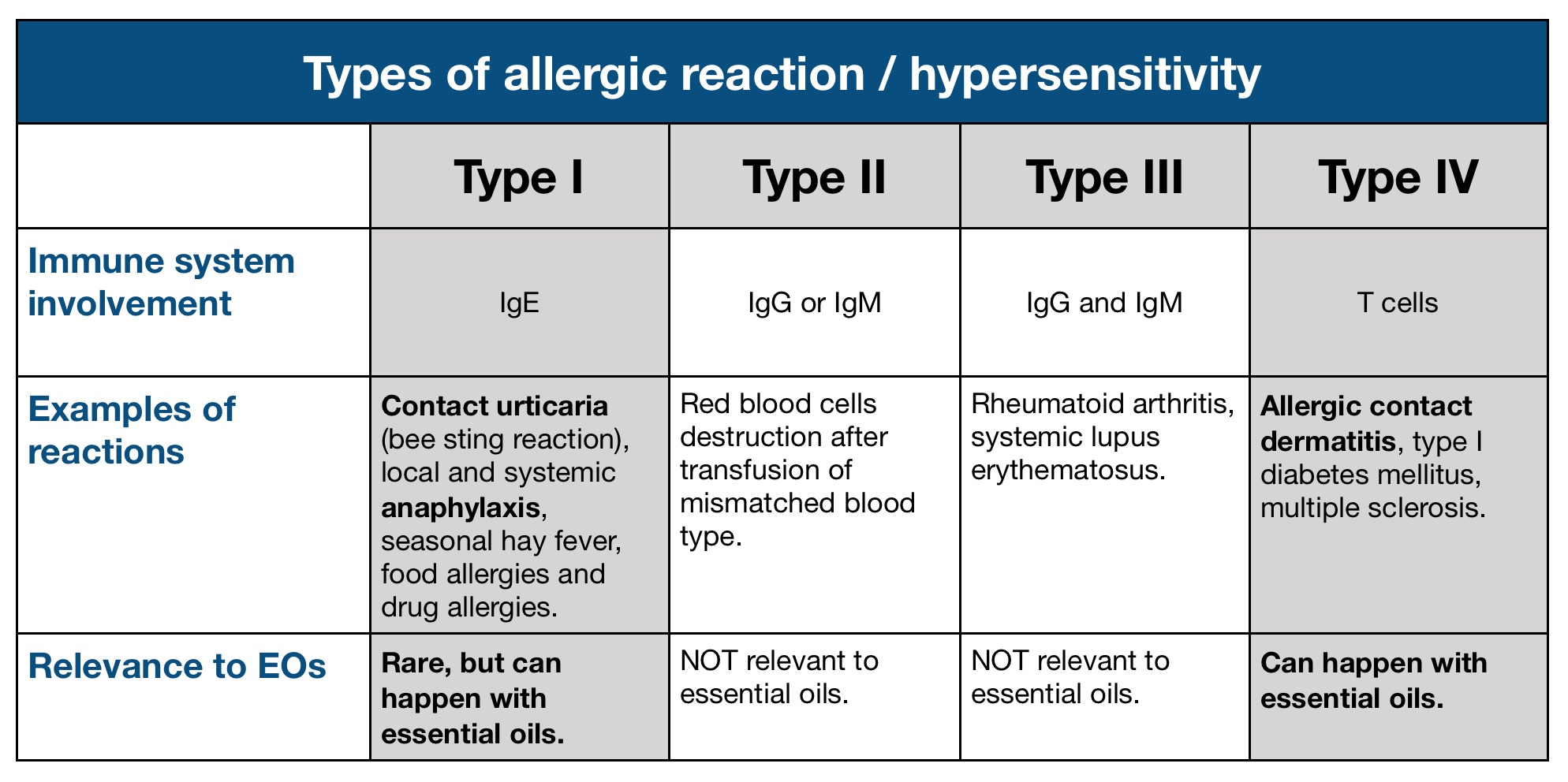
Rarely allergic to grain products (buckwheat, wheat, rye, oats), meat, legumes, onions, celery, various spices.
Thus, it is possible to give an approximate general list of foods for allergies.
Do not use:
– broth,
– spicy,
– salted,
– fried,
– smoked,
– spices,
900 02 – sausage and sausage products (boiled sausage, smoked sausage, sausages, sausages, ham
– liver,
– fish and other seafood,
– chicken egg,
– spicy cheese, processed cheese,
– ice cream,
– mayonnaise, ketchup, margarine,
– vegetables: radish , radish, sorrel, spinach, tomato, sweet pepper, sauerkraut, pickled cucumber,
– mushrooms
– nuts
– fruits: citrus, apricot, peach, pomegranate, grapes, kiwi, pineapple, melon
– berries: strawberries, strawberries, raspberries, sea buckthorn, watermelon, 900 03
– refractory fats,
– soda, kvass, coffee, cocoa, chocolate,
– sweets: honey, caramel, marshmallow, marshmallow, cake, pastry, muffin
You can use:
– cereals (with the exception of semolina),
– fermented milk products: kefir, biokefir, natural yogurt without additives, etc.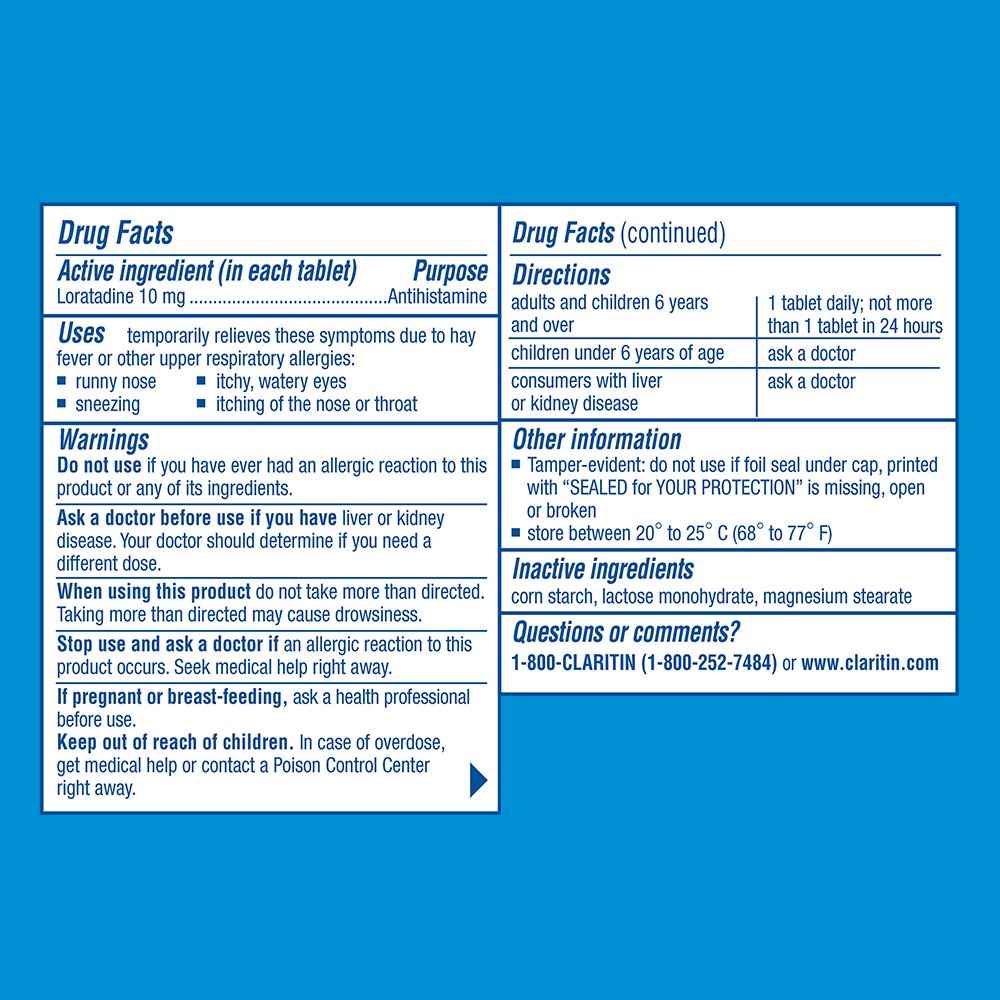 ),
),
How to overcome allergies without drugs
Health
May 9, 2022
Perhaps garlic will be your salvation.
You can listen to the short version of the article. If it’s more convenient for you, turn on the podcast.
Let’s make it clear right away: not every allergy can be overcome without medicines and the help of doctors.
If an allergic reaction affects the respiratory tract or develops too violently, causing swelling, redness, itching and other effects throughout the body, call an ambulance or contact the clinic as soon as possible. Anaphylaxis, that is, a severe form of allergy, is deadly and requires immediate medical attention. Expecting that you will cope with this condition without specialists is at least irresponsible.
Also, you should not refuse medicines if they are prescribed to you by an allergist.
But if the allergy occurs only from time to time and is limited to unpleasant but harmless symptoms – sneezing, runny nose, reddened eyes and nose, watery eyes, skin reactions – you can try to tame it without drugs.
The key word here is try. Evidence-based medicine does not give guarantees that non-drug remedies will definitely help. However, he hopes.
1. Identify the trigger and avoid it
An allergy is an overreaction of the immune system to a particular irritant that has entered the body. Such an irritant can be, for example, the pollen of trees and plants. If so, they talk about hay fever.
Triggers, that is, substances that provoke an allergic reaction, also include house dust and mites living in it, dander and saliva of pets, mold, food, components of medicines.
Try to find out what exactly makes you sneeze and shed tears. In your investigation, you can focus on the seasons and how often the symptoms appear. For example, if an allergy occurs in spring, late summer or early autumn, and in other periods you live calmly, most likely it is hay fever. If there are adverse reactions throughout the year, they may be due to house dust, mold, contact with animals, or something that you have eaten.
The best way to find a trigger is to get tested for allergens.
Once you identify an irritant, try to avoid it. This alone can protect you from allergic manifestations.
2. Try to avoid cross-allergy
Cross-allergy is when a reaction to one allergen is exacerbated by a reaction to another.
For example, an allergy to birch pollen may increase if you eat apples. On wormwood pollen – if you smell chamomile. On cat hair (in the sense, particles of cat skin and saliva) – if you eat pork.
If you know your allergen, talk to your doctor about the risk of cross-allergy. You may have to avoid not only the immediate irritant, but also some seemingly innocent foods or plants.
3. Eat more onions and garlic
These vegetables are high in quercetin, an antioxidant that has been reported to inhibit the release of histamines. This is the name of the special chemicals responsible for the development of an allergic reaction.
Try adding onions and garlic to your meals.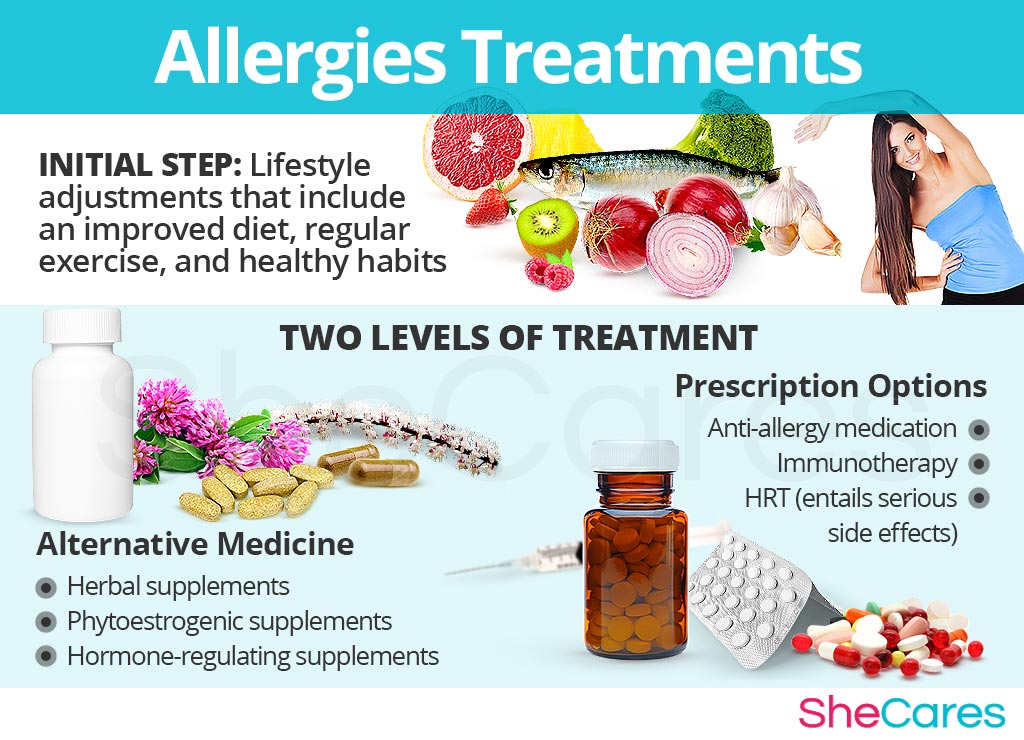 Perhaps they will be your salvation. But not a fact: studies of their effectiveness are still not enough.
Perhaps they will be your salvation. But not a fact: studies of their effectiveness are still not enough.
Yes, supplementing with quercetin is not a solution. In this form, the anti-allergic properties of the antioxidant are markedly reduced.
Dean Mitchell
MD, allergist, in a comment to Good Housekeeping.
I see only minimal benefit from such drugs.
4. Try Butterbur
A small randomized trial showed butterbur extract to be as effective as over-the-counter antihistamines. At least against allergic rhinitis.
True, only 131 people participated in the study. This, from the point of view of evidence-based medicine, is still not enough for unambiguous conclusions about the effectiveness of butterbur.
There is no evidence that the extract from the root and leaves of the shrub helps with allergic skin reactions and asthma. But there is evidence that butterbur can be toxic to the liver and cause a range of adverse reactions, from belching, headache, and diarrhea to allergic cross-reaction in people sensitive to ragweed, chrysanthemum, marigold, and chamomile pollen.
Therefore, before experimenting with a supplement, be sure to talk about it with your doctor, at least a therapist.
5. Add rosemary to your meals
One small study showed that taking rosemary extract can significantly reduce the symptoms of difficult-to-treat asthma, including allergic asthma. The participants in the experiment noted that they began to cough less, almost got rid of wheezing in the chest and obsessive sputum production.
However, more research is needed to conclude on the anti-allergic efficacy of rosemary.
6. And turmeric
This spice has the same story as butterbur and rosemary.
In 2016, a pilot study was conducted with 241 people suffering from allergic rhinitis. It turned out that those who took turmeric supplements for two months had significantly reduced symptoms. In particular, people said that their nasal congestion almost disappeared.
However, research on the antiallergic properties of turmeric is still scarce.


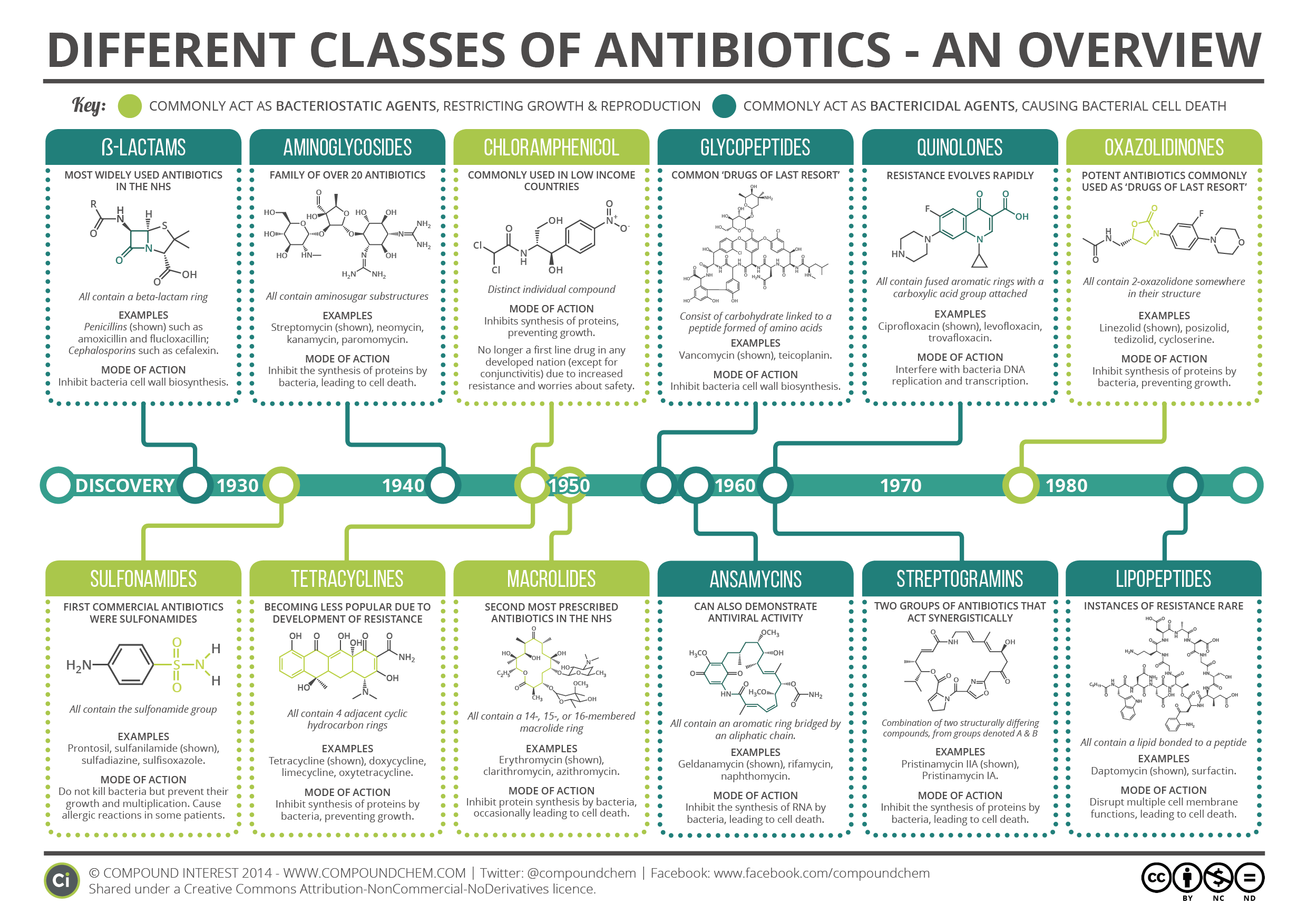 Corticosteroids contain steroids that reduce inflammation and itching. Mild forms of these creams can be found online, and a doctor can prescribe stronger versions.
Corticosteroids contain steroids that reduce inflammation and itching. Mild forms of these creams can be found online, and a doctor can prescribe stronger versions. Immunotherapy can be between 90 and 98 percent effective at reducing allergic reactions to insect stings, for instance.
Immunotherapy can be between 90 and 98 percent effective at reducing allergic reactions to insect stings, for instance.:max_bytes(150000):strip_icc()/penicillin-allergies-2634584-01-8e7ad55b8d914e23a20b9597af84dc63.png) These can also be taken as supplements.
These can also be taken as supplements.
 Corticosteroids contain steroids that reduce inflammation and itching. Mild forms of these creams can be found online, and a doctor can prescribe stronger versions.
Corticosteroids contain steroids that reduce inflammation and itching. Mild forms of these creams can be found online, and a doctor can prescribe stronger versions. Immunotherapy can be between 90 and 98 percent effective at reducing allergic reactions to insect stings, for instance.
Immunotherapy can be between 90 and 98 percent effective at reducing allergic reactions to insect stings, for instance.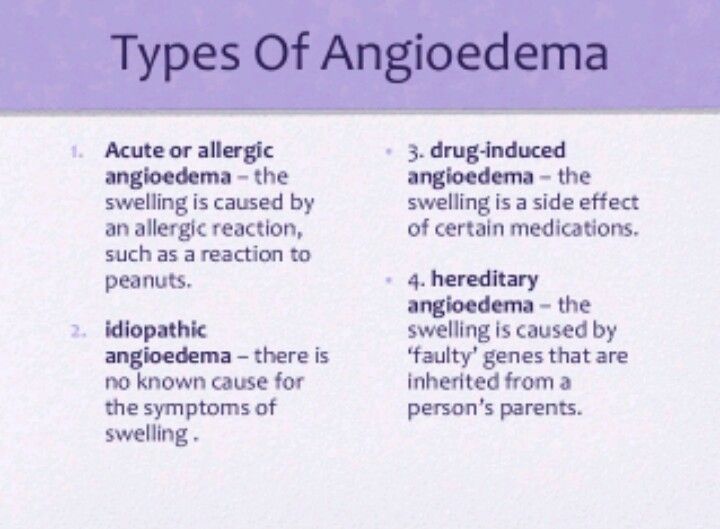 These can also be taken as supplements.
These can also be taken as supplements.